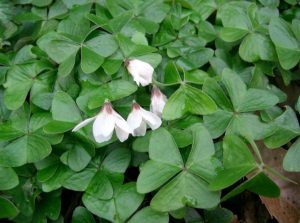Everyone associates the shamrock with St. Patrick’s Day.
St. Patrick, Ireland’s patron saint, we all learned at some point, used the plant with the three-lobed leaf to explain the Holy Trinity to his pagan flock. “But St. Patrick lived about A.D. 400, and it isn’t until the 1600s that we have the first known written documentation of this story,” said Peter Wyse Jackson, president of the Missouri Botanical Garden and the George Englemann Professor of Botany at Washington University in St. Louis.

Wyse Jackson, the author of “Ireland’s Generous Nature: The Past and Present Uses of Wild Plants in Ireland,” was born in in Kilkenny, Ireland. He is a graduate of Trinity College Dublin and former director of the National Botanic Gardens of Ireland.
“Folklore is an imprecise science,” Wyse Jackson said. So imprecise that there is even debate about which plant is the “true” shamrock.
“The name shamrock comes from the Irish seamróg, meaning little clover,” he said. “Óg means ‘little’ or ‘young,’ so when I was growing up a father and son down the road might be called Paddy and Paddy Óg.”
The clover that is traditionally worn on St. Patrick’s Day in Ireland is a little annual species called Trifolium dubium, the lesser clover, he said. It is native to Europe but has migrated to America, where it infests lawns, to homeowners’ annoyance.
Occasionally the larger white clover is worn as well, but the plant commonly sold as a decorative shamrock in St. Louis florists is a sorrel, Oxalis griffithii. It’s another species entirely, Wyse Jackson said.

The symbolism of the shamrock has a different basis than the magical associations with the four-leaf clover, he said, although the two traditions have become muddled.
As an ethnobotanist, Wyse Jackson can also tell you of the many other uses for shamrocks besides adornment. Shamrock was eaten in Ireland in times of famine, he said, and one 18th-century writer recommended chewing it to sweeten the breath. Shamrock was also crushed and mixed with butter to make an ointment for lumbago (back pain).

“But the sufferer was told it had to be left on the back until the pain was gone. So I would imagine after a while the smell would be a little unwholesome,” he said.
Why green carnations?
The wearing of green carnations is a tradition of much more recent origin than the wearing of shamrocks. The green carnation was popularized by the 19th-century Irish playwright and author Oscar Wilde and became a symbol of the aesthetic movement, whose members believed in “art for art’s sake,” rather than in the service of a higher moral or social purpose.
When asked about the symbolism of the green carnation, Wilde responded rather cryptically, “Nothing whatever, but that is just what nobody will guess.”
Many years later, in the song, “We All Wore a Green Carnation,” Noël Coward called the green carnation a badge for “naughty boys” during the “Gay Nineties,” known as the “Naughty Nineties” in the United Kingdom. The whole thing is a bit of a linguistic snare for the unwary, because the phrase the “Gay Nineties” wasn’t used until the 1920s, and, in any case, had nothing to do with the modern usage of the term “gay.”
“Of course there are no truly green carnations,” Wyse Jackson said. “They’re all dyed flowers. I have a colleague, Charles Nelson, an Irish botanist, who has discovered American newspaper advertisements from the 1920s for the florists’ dye that was used.”
Drowning the shamrock
St. Patrick’s Day was originally just another of many feast days in the Roman Catholic liturgical calendar. Since it fell in (abstemious) Lent, the faithful could indulge in a few St. Patrick’s “pots” only by special dispensation.
“I’ve come across religious tracts that said it was a disgrace that St. Patrick’s Day was used as an excuse for ‘excessive liquor and debauchery,’ ” Wyse Jackson said.
St. Patrick’s Day didn’t become a public holiday in Ireland until 1903, but the Irishman who introduced the bill to make it a holiday later had to introduce a bill to close the pubs on March 17.
That law, which remained in force until the 1970s, had an unintended consequence, Wyse Jackson said. The Irish Kennel Club held its annual dog show in Dublin on St. Patrick’s Day, and it was said to be the only place in Dublin where you could get a drink. “So you can imagine attendance at the dog show was really high,” Wyse Jackson said.
Wearing of the green

“Wearing of the Green” is an Irish street ballad that dates to the Irish Rebellion of 1798, launched by the revolutionary republican organization that launched the rebellion, the United Irishmen. As the ballad bitterly says, “They’re hanging men and women there for the wearing o’ the green.”
But one of the things that is a little unclear is whether the wearing of the green refers to green garments, the green cockade the United Irishmen wore in their hats, or the shamrock itself.
It’s probably a reference to the uniforms the United Irishmen wore, but one version of the lyrics runs:
Oh, Paddy, dear, and did ye hear the news that’s goin’ round?
The shamrock is by law forbid to grow on Irish ground!
Many of the stories associated with St. Patrick’s Day are hard to pin down, Wyse Jackson said. “It has even been suggested that there was more than one St. Patrick. Perhaps several individuals have been combined into one.
“But, as they say in Ireland, ‘You should never let the truth get in the way of a good story,’ ” he said.
